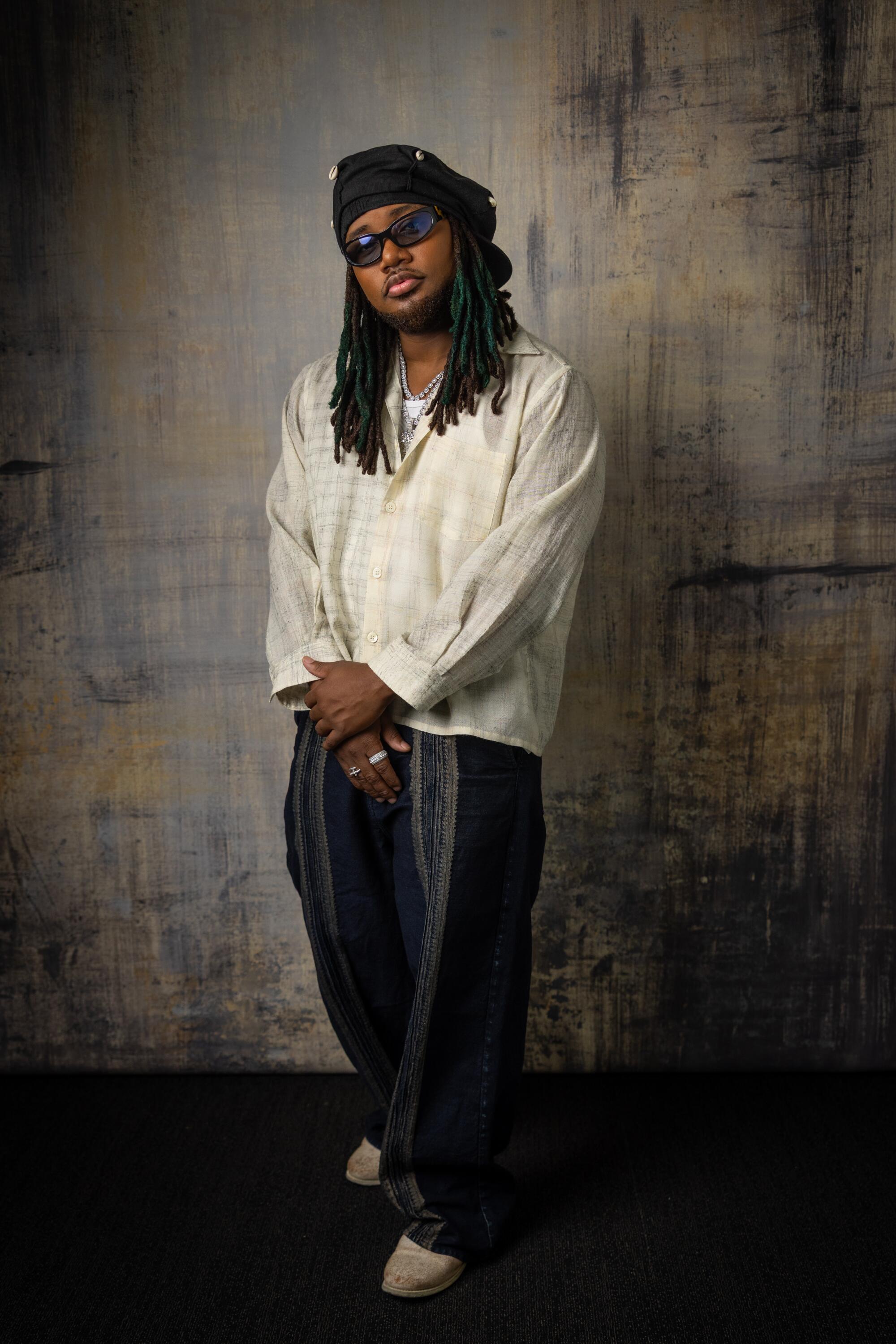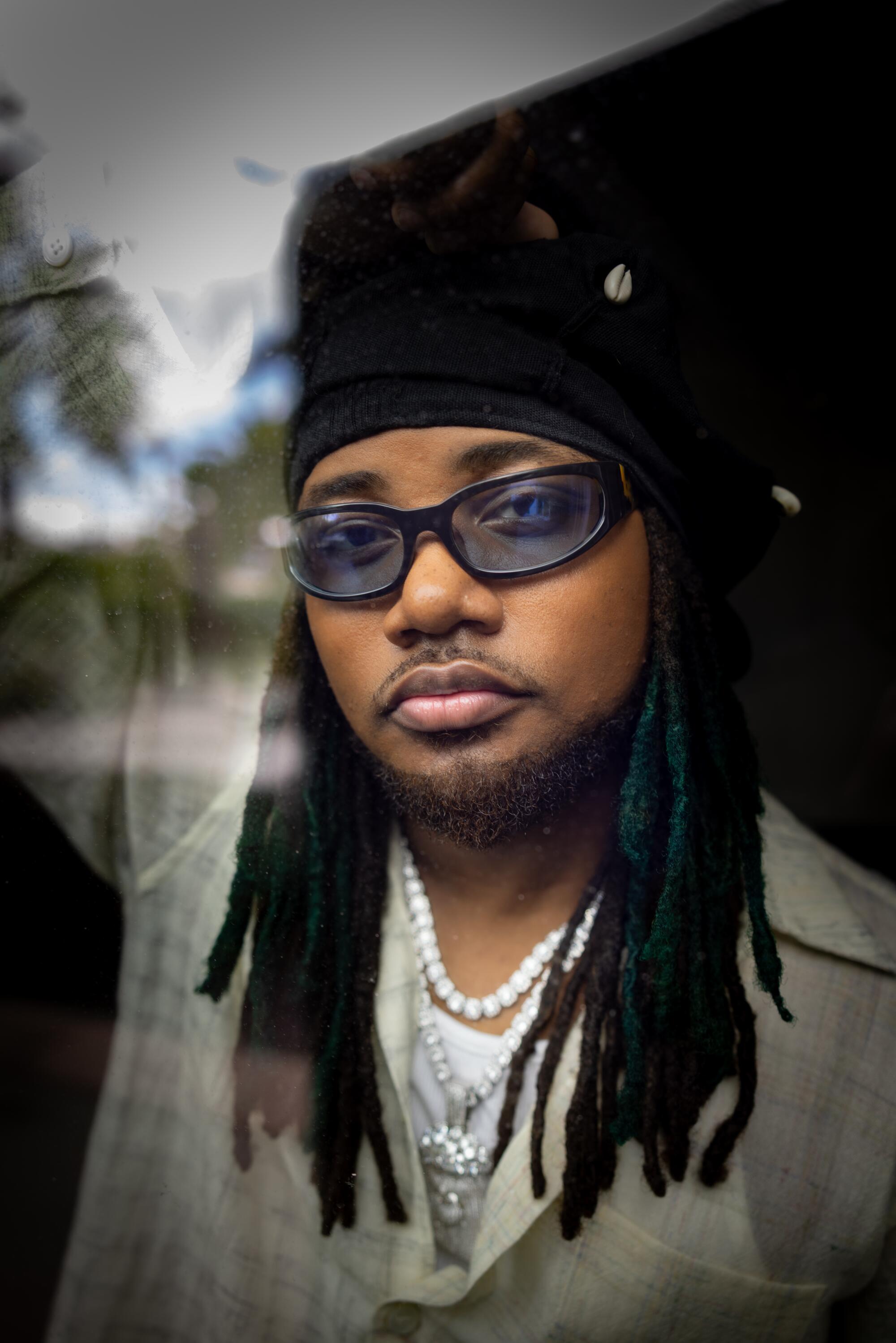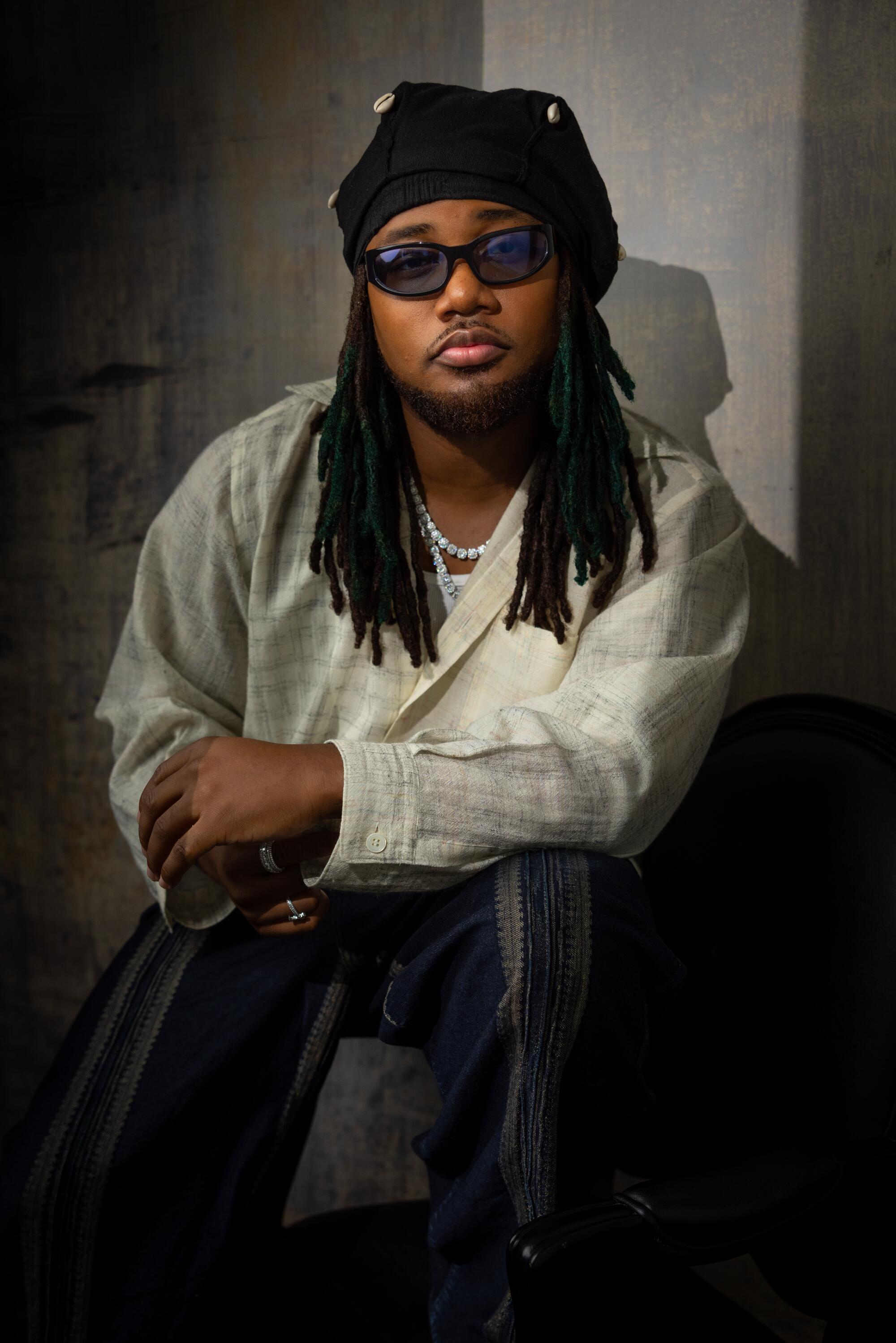Leon Thomas talks Nickelodeon, Grammys and his breakout single “Mutt”
Leon Thomas recently dyed the tips of his signature locs dark green. His new hair color — a stark contrast from the vibrant red he’d been rocking for the last four years — is the first thing that stands out about him when he strolls into the Los Angeles Times building on an unusually rainy day in October.
When asked about his hair, which peeks out from underneath a black beret-style hat, a wide grin stretches across his face.
“I had a vision,” the 32-year-old singer says, leaning in. “In [this] vision, I had more tats, a six pack and I had green dreads. And I was like, ‘You know what, let’s work on it.’” He’s been working out more consistently and he has his eyes set on a couple of tattoo artists in L.A. and Europe, but the new hair kicked everything off.
“That’s how the rest of my life has worked: I’ve seen something in my head, I’ve seen a version of myself that’s not there yet and then you work hard to get there.”
This instinct has carried Thomas throughout his 20-plus-year career in the entertainment industry, and has cleared a path for him to emerge as a leading force in modern R&B music. After years of dedicating his skill to acting, writing and producing chart-topping bangers for artists like Drake, Ariana Grande and SZA (he won his first Grammy for her record “Snooze”), for the first time Thomas is up for six Grammy nominations including album of the year and best new artist for his own work.
“I feel like this is a byproduct of me finally having a machine that works,” Thomas says about his team. He signed to EZMNY, a record label co-founded by Grammy-nominated artist Ty Dolla $ign and A&R executive Shawn Barron, in 2021. He takes an audible breath before continuing, “Not to sound cocky or anything, but I just always felt in my heart of hearts that once people could finally hear what I had to offer, it would be a different story. I’m glad that God gave me the foresight to see that.”

He has good reason to be feeling himself these days. “Mutt,” his breakout 2024 single, quietly simmered for months before it was pushed into ubiquity. The track’s metaphorical meaning — comparing his own flawed behavior in relationships to a “mutt” or a dog with good intentions — along with a sensual bassline and knocking drums eventually became a sleeper hit. It also became a favorite for Tems, SZA, Keke Palmer and Issa Rae, who shouted out the song in interviews.

“That’s how the rest of my life has worked: I’ve seen something in my head, I’ve seen a version of myself that’s not there yet and then you work hard to get there,” said Leon Thomas.
(Jason Armond/Los Angeles Times)
By early this year, the song, which is the title track from his sophomore album, had cracked the Hot 100 Billboard charts, recently climbing to No. 1 on Billboard’s radio songs chart, earning double platinum status.
The success of the album and the deluxe edition that followed launched Thomas into a whirlwind of promo: radio and podcast stops, interviews galore and after-party appearances. Meanwhile, he’s still made time to make records with other artists like Wale, Disclosure, Odeal and Sasha Keable. He kicked off his “Mutts Don’t Heel” tour in October, and this year alone, he’s had more than 70 performances, including the Hollywood Bowl with Inglewood-born singer SiR, “Jimmy Kimmel Live” and the BET Awards (where he won best new artist). Earlier this year, Thomas stopped by NPR’s Tiny Desk, a live set that has more than 4 million views and has since been turned into an EP. (His Tiny Desk performance also received a Grammy nod for best R&B performance.)
“It’s been nonstop like something great happening every single week,” says Barron, co-founder of EZMNY.
Long before fans were belting out the lyrics “I’m a doggggg / I’m a mutt,” Thomas was getting his first taste of what it takes to be a musician from his family. Thomas’ late grandfather, John Anthony, was an opera singer who starred in the 1976 Broadway production of “Porgy & Bess.” His mother — a singer — and his stepfather — who played guitar for B.B. King — were part of New York’s Black Rock Coalition and “didn’t believe in babysitters,” says the Brooklyn native who now resides in L.A. He has fond memories of doing his homework while his parents were performing and hopping on stage at times to hit a dance move for a packed crowd.
At just 10 years old, Thomas booked the role of Young Simba on Broadway after a family friend encouraged him to audition. He went on to star in more productions, including “Caroline, or Change” and “The Color Purple,” before booking his first film, “August Rush” (starring late actor Robin Williams), which required him to learn to play the guitar. As a result, he began writing his own songs, one of which impressed his parents so much that they booked studio time and a session bass player to help him to lay down the track. “It definitely influenced my perspective on if I could actually make professional music or not,” recalls Thomas, who plays five instruments, including drums (his first love), guitar, bass, piano and saxophone.

“Not to sound cocky or anything, but I just always felt in my heart of hearts that once people could finally hear what I had to offer, it would be a different story. I’m glad that God gave me the foresight to see that,” said Leon Thomas.
(Jason Armond/Los Angeles Times)
By age 13, Thomas had signed a development deal with Nickelodeon that came with a Columbia Records recording contract. After appearing in various shows like “The Backyardigans” and “iCarly,” he snagged the role of André Harris, a high-school-age singer and multi-instrumentalist, on the tween sitcom “Victorious” alongside star-in-the-making Grande.
When the show ended in 2013, Thomas began working with one of modern music’s most decorated architects, Babyface, who introduced him to producer and songwriter Khris Riddick-Tynes. Together, Thomas and Riddick-Tynes formed the Rascals and began producing records like Rick Ross’ “Gold Roses” featuring Drake (which received a Grammy nomination), “I’d Rather Be Broke” by Toni Braxton and SZA’s “Snooze,” which won best R&B song at the Grammys in 2024.
Still, pivoting from wholesome Nickelodeon star to a grown R&B artist didn’t happen overnight. “The biggest thing for me was just taking time away from the artistry in order to really allow people to celebrate the brand that I had built, but give me room to build something else,” he says. “Space and time can be a tough thing because you’re gonna have to reintroduce yourself even though you did a lot of work in the beginning to build what you had before, but I think it’s beautiful to kind of build a brand from scratch.”
That’s one of the reasons why the cover of his reintroduction project, “Genesis,” features a distorted forest instead of his face. “I didn’t want them to connect with what I was saying, what I was talking about, the feelings [and] the sounds,” he says. With every release, he’s slowly revealed more of himself.
Onstage, Thomas channels the intensity of some of his musical heroes — James Brown, Prince, Jimi Hendrix and D’Angelo. His music may sit comfortably under the R&B umbrella, but he bends and flips genres with ease, especially rock and funk. In TikTok recaps from his current tour, he can be seen ripping on the bass and guitar, whipping his body into turns and effortlessly hitting vocal runs, which fans have attempted to imitate. With him, you never have to question if the mic is on.
“Sometimes I go see R&B artists live and it’s very chill,” he says, but “the school I come from is competitive.” He recalls stories that his stepfather has told him about performing at the Village Underground in New York when he was coming up. “They used to do something called cutting heads, so the first guy would go do his solo, then the guy who came out on the second set had to go even further. He’s playing with his teeth, he’s spinning, he’s on the floor, he’s wildin’,” Thomas says excitedly.
“So I’m in that school of thinking when I hit a stage and for this tour where I get to curate things and really put it together like I want to, there’s gotta be that energy of cutting heads,” he adds.

Just days before launching his 27-city tour, Thomas released a cinematic trailer featuring Rae — who played his neighbor and hookup buddy on “Insecure” — to introduce his latest project, “Pholks.” The seven-track release, created in collaboration with musicians Rob “Freaky Rob” Gueringer and David Phelps, a.k.a. “D. Phelps” (who also worked on “Mutt”), is an homage to the funk, rock and soul artists who’ve inspired him. Led by the singles “Just How You Are” and “My Muse,” which could trigger a “Soul Train” line at any moment, the project feels warm and nostalgic, yet anchored in forward-thinking production and playful storytelling that helps push it into the future.
In April, Ty Dolla $ign brought Thomas out to perform during his headlining set at Coachella, a moment that was a no-brainer for Ty, who recently called Thomas “the new king” of R&B.
“I just can’t even believe that I was the one to be able to do this,” Ty says about working with the singer.

“Sometimes I go see R&B artists live and it’s very chill,” Leon Thomas said, but “the school I come from is competitive.”
(Jason Armond/Los Angeles Times)
In the midst of this busy season, Thomas has been more intentional about maintaining his mental health. “I’m doing a lot of grounding meditations,” he says, noting that family and his tight circle of friends have been an essential support system. “I’ve been picking up the Bible a little bit more.”
He also finds steadiness in revisiting wisdom passed down from his late grandfather, who passed away last year, and reflecting on his “why:” bringing a classic, musician-centered energy back to R&B and encouraging young artists to pick up an instrument.
“When a little kid sees me playing guitar on the Grammy stage or if they see me performing on Instagram playing drums, I want them to ask their mom for a guitar or some drum lessons,” he says. With the rise of AI, he says that live musicianship may become less common. “I hope that we can inspire a revolution of intelligence, people who are intelligently making music and coming from a standpoint of history.”
Thomas will close out his whirlwind year with two shows at the Wiltern on Dec. 22 and 23 before embarking on the European leg of his tour in March and heading to Australia in June. In the meantime, he’s trying to avoid thinking about the Grammys in February — though everyone, including myself, is making it impossible for him not to.
Whether he walks away with a golden gramophone or not, Thomas has already created a body of work that has reinvigorated not only R&B but also music in general, and he plans to continue pushing himself creatively. He’s known all along what he’s capable of and the career he’s destined to have because he’s envisioned it. It’s the world that’s had to catch up.
